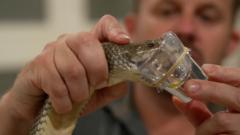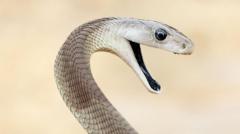Despite their deadly nature, Australia's most dangerous animals play a vital role in medical advancements and saving lives.
**Australia's Deadliest Creatures: Unlikely Heroes in Antivenom Production**

**Australia's Deadliest Creatures: Unlikely Heroes in Antivenom Production**
How venomous snakes and spiders are crucial to saving lives in Australia.
In a dimly lit room filled with large plastic containers, Emma Teni, a dedicated spider milker, skillfully extracts venom from Sydney funnel-web spiders at the Australian Reptile Park. With pink tweezers in hand, she captures the arachnids, aware that these palm-sized spiders are among the deadliest in the world. "Sydney funnel-webs could kill in just 13 minutes," she states, emphasizing the importance of the antivenom program that has prevented fatalities since its inception in 1981.
This program relies on public support to catch these spiders and bring them to experts like Emma. Each week, her team traverses Sydney in a van adorned with cartoonish reptiles, collecting spiders turned in by concerned citizens. Charlie Simpson, a local handyman who caught two spiders himself, reflects, “Catching one has helped me face my fear of arachnids.” Emma encourages public involvement, stating, “If you find one, please bring it to us instead of killing it. You could save a life.”
The venom collected is essential for producing the antivenom that treats funnel-web bites. Emma explains that the venom from males, which is significantly more toxic, is especially valuable. To produce just one vial of antivenom, approximately 200 spiders must be milked, as each contributes only a small amount of venom.
Beyond spiders, the park also plays a pivotal role in snake venom extraction. Operations manager Billy Collett carefully secures a King Brown snake to collect venom, vital for creating antivenoms that save lives. Australia’s antivenom success story has led to a stark contrast with global snake bite statistics, where approximately 140,000 fatalities occur annually.
The process of developing antivenom is intricate and lengthy, typically involving horses and rabbits. The venom is freeze-dried and shipped to a specialized lab where it undergoes further processing. Each year, CSL Seqirus produces around 7,000 vials of antivenom, distributed to different regions according to specific species threats.
Dr. Jules Bayliss, leading the antivenom team, emphasizes the importance of ensuring these life-saving supplies reach rural and remote communities. Surprisingly, the antivenom also extends beyond Australia’s borders, providing aid to Papua New Guinea's rural audiences, a once-connected part of Australia.
Despite the fears surrounding snakes and spiders, experts like Collett encourage the public to view these creatures with respect rather than dread, noting that they usually avoid humans and will only bite if provoked. With the best antivenom system in the world, they assure that Australia remains a safe place for those in need of critical medical treatment.
This program relies on public support to catch these spiders and bring them to experts like Emma. Each week, her team traverses Sydney in a van adorned with cartoonish reptiles, collecting spiders turned in by concerned citizens. Charlie Simpson, a local handyman who caught two spiders himself, reflects, “Catching one has helped me face my fear of arachnids.” Emma encourages public involvement, stating, “If you find one, please bring it to us instead of killing it. You could save a life.”
The venom collected is essential for producing the antivenom that treats funnel-web bites. Emma explains that the venom from males, which is significantly more toxic, is especially valuable. To produce just one vial of antivenom, approximately 200 spiders must be milked, as each contributes only a small amount of venom.
Beyond spiders, the park also plays a pivotal role in snake venom extraction. Operations manager Billy Collett carefully secures a King Brown snake to collect venom, vital for creating antivenoms that save lives. Australia’s antivenom success story has led to a stark contrast with global snake bite statistics, where approximately 140,000 fatalities occur annually.
The process of developing antivenom is intricate and lengthy, typically involving horses and rabbits. The venom is freeze-dried and shipped to a specialized lab where it undergoes further processing. Each year, CSL Seqirus produces around 7,000 vials of antivenom, distributed to different regions according to specific species threats.
Dr. Jules Bayliss, leading the antivenom team, emphasizes the importance of ensuring these life-saving supplies reach rural and remote communities. Surprisingly, the antivenom also extends beyond Australia’s borders, providing aid to Papua New Guinea's rural audiences, a once-connected part of Australia.
Despite the fears surrounding snakes and spiders, experts like Collett encourage the public to view these creatures with respect rather than dread, noting that they usually avoid humans and will only bite if provoked. With the best antivenom system in the world, they assure that Australia remains a safe place for those in need of critical medical treatment.


















